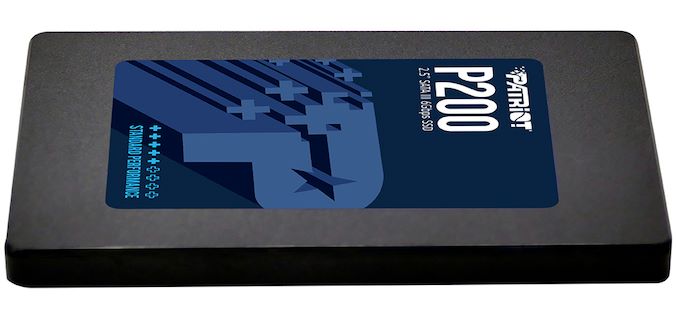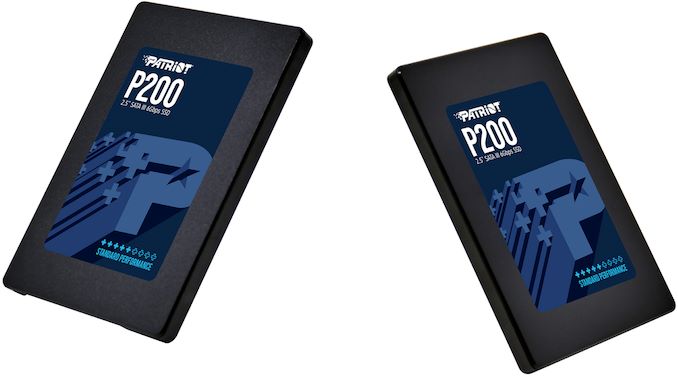Patriot Launches P200 SSDs with Maxio and Silicon Motion Controllers: From $31.99
by Anton Shilov on July 18, 2019 1:00 PM EST
Patriot has introduced its new family of entry-level SATA SSDs offering capacities from 256 GB to 2 TB. The P200-series drives use controllers from Maxio Technology and Silicon Motion, the first time in years that Patriot uses controllers not from Phison.
Available in a 2.5-inch/7 mm form-factor, the Patriot P200 drives feature 256 GB, 512 GB, and 1 TB configurations and are based on Silicon Motion’s SM2258XT controllers, whereas the top-of-the-line 2 TB model is powered by Maxio Technology’s MAS0902A controller. The drives are powered by 3D NAND memory, but the manufacturer does not disclose exact model of chips or their manufacturer (we do know that SMI and Maxio controllers can work with memory from various vendors though).
As far as performance is concerned, Patriot says that its P200-series SSDs can offer up to 530 MB/s sequential read speeds, up to 460 MB/s sequential write speeds, up to 90K random read IOPS, as well as up to 80K random write speeds. Performance wise, the new drives from Patriot offer similar speed levels as other SATA 6 Gbps SSDs.
When it comes to endurance levels, Patriot’s P200 SSDs can offer 0.45 – 0.58 drive writes per day (DWPD), which is actually higher when compared to 0.3 DWPD offered by cheap 3D QLC NAND-based drives these days.
All Patriot’s P200 SSDs are covered by a three-year warranty and are available now for $31.99 - $189.99, depending on capacity.
| Patriot's P200 Specifications | ||||
| Capacity | 256 GB | 512 GB | 1 TB | 2 TB |
| Model Number | P200S256G25 | P200S512G25 | P200S1TB25 | P200S2TB25 |
| Controller | Silicon Motion SM2258XT | Maxio MAS0902A | ||
| NAND Flash | 3D NAND | |||
| Form-Factor, Interface | 2.5-inch/7-mm, SATA 6 Gbps | |||
| Sequential Read | up to 530 MB/s | |||
| Sequential Write | up to 460 MB/s | |||
| Random Read IOPS | up to 90K | |||
| Random Write IOPS | up to 80K | |||
| Pseudo-SLC Caching | Supported | |||
| DRAM Buffer | No | |||
| AES Encryption | unknown | |||
| Power Management | Automatic sleep and wake-up mechanism power saving | |||
| Warranty | 3 years | |||
| MTBF | 2,000,000 hours | |||
| TBW | 160 TB | 320 TB | 640 TB | 1000 TB |
| DWPD | 0.57 | 0.57 | 0.58 | 0.45 |
| Price at Launch | $31.99 | $49.99 | $87.99 | $189.99 |
Related Reading:
- More 2TB PCIe 4.0 SSD Options: Patriot with Custom Firmware coming Q4
- Maxiotek Unveils MK8115: Low-Cost SSD Controller for 3D NAND SATA SSDs
- Maxio Technology Demos SSD Based on ‘Chinese’ 3D NAND
- Micron’s 96-Layer 3D TLC NAND Demonstrated, Qualified by Maxio, SMI
Source: Patriot











20 Comments
View All Comments
Teckk - Thursday, July 18, 2019 - link
I got a Samsung 850 EVO 256 GB SSD ~2 years ago and that was around 100$ at that time. I don't know how it compares to the Samsung drive but wow has the price come down. Samsung EVI 860 is around 60$ now.Teckk - Thursday, July 18, 2019 - link
Moore's Law is alive and well for storage? The price of SSds will halve every 2 years? (and you'll cry a little inside)PeachNCream - Thursday, July 18, 2019 - link
I fairly recently purchased a 2.5" SATA 1TB Patriot Burst because the list price was roughly $109 on Amazon. Only time will tell if it will endure, but so far it's been sufficient at not attracting my notice as a performance problem or bottleneck. I'm on the market for another 1TB SSD so given the endurance rating, a P200 is probably going to end up on my list of options given the sub-$90 price.Cullinaire - Thursday, July 18, 2019 - link
32 bucks? Have we reached the floor of how cheaply SSDs could be sold for? Granted, they have less material overhead compared to mechanical HDDs, but still, wow.eek2121 - Thursday, July 18, 2019 - link
Not really. Prices could go lower if companies sacrificed performance, reliability, and capacity. You can buy USB sticks for as low as $9.99 for instance.hojnikb - Friday, July 19, 2019 - link
Price floor for flash drives is closer to 3$.kaidenshi - Sunday, July 21, 2019 - link
Yep, and even name brand microSD cards like Samsung and PNY are around $10 or less for 32GB. I thought we'd see the price go up a bit because of the reported shortages, but so far it's been falling steadily.MASSAMKULABOX - Friday, July 19, 2019 - link
I think $30 is about as low as they want to go .. possibly they could go lower but the unit profit becomes too low to justify.. they simply drop the lowest capacity eg 60,120,240 . That also works as newer NAND chips are hamstrung when only using one or two rather than four or eight. Glad I'm waiting it out for 1Tb ..prices keep getting lower. YAY.melgross - Friday, July 19, 2019 - link
True, but sticks are tiny. There’s not much there. These are much bigger. They have controller chips, which sticks don’t. I think this is about the bottom. A few bucks lower, maybe.hojnikb - Friday, July 19, 2019 - link
Actually, you're wrong here. USB flash drives have exactly the same basic components as SSD. You need a nand flash, flash controllers and other passive components (like capacitors, resistors, voltage regulators). The only real difference is that some SSDs also use DRAM (most flash drives don't) and have bit more complex PCBs to accomodate more flash chips.But the basic design is the same. Just crack open a typical budget ssd and flash drive and you'll see.